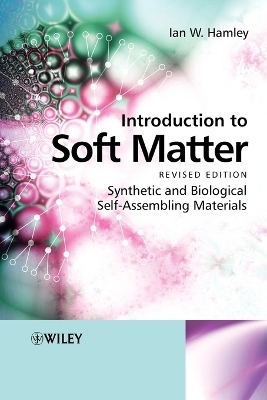
Introduction to Soft Matter
John Wiley & Sons Inc (Verlag)
978-0-470-51610-2 (ISBN)
This book provides an introduction to this exciting and relatively new subject with chapters covering natural and synthetic polymers, colloids, surfactants and liquid crystals highlighting the many and varied applications of these materials. Written by an expert in the field, this book will be an essential reference for people working in both industry and academia and will aid in understanding of this increasingly popular topic.
Contains a new chapter on biological soft matter
Newly edited and updated chapters including updated coverage of recent aspects of polymer science.
Contain problems at the end of each chapter to facilitate understanding
Ian Hamley is the Diamond Professor of Physical Chemistry at Reading University (UK). He was educated at Reading University gaining a BSc in Chemical Physics and he received his PhD at the University of Southampton in 1991. He has published many scientific papers in leading journals and his research interests include 'polymer nanotechnology, self assembly, soft materials and soft matter'. Professor Hamley has (co)written four books for Wiley (Block Copolymers in Solution, Nanoscale Science and Technology, Developments in Block Copolymer Science and Technology, and Introduction to Soft Matter) and one for OUP entitled The Physics of Block Copolymers.
Preface to the revised Edition. Preface to the First Edition.
1. Introduction.
1.1 Introduction.
1.2 Intermolecular Interactions.
1.3 Structural Organization.
1.4 Dynamics.
1.5 Phase Transitions.
1.6 Order Parameters.
1.7 Scaling Laws.
1.8 Polydispersity.
1.9 Experimental Techniques for Investigating Soft Matter.
1.10 Computer Simulation.
Further Reading.
2. Polymers.
2.1 Introduction.
2.2 Synthesis.
2.3 Polymer Chain Conformation.
2.4 Characterization.
2.5 Polymer Solutions.
2.6 Amorphous Polymers.
2.7 Crystalline Polymers.
2.8 Plastics.
2.9 Rubber.
2.10 Fibres.
2.11 Polymer Blends and Block Copolymers.
2.12 Dendrimers and Hyperbranched Polymers.
2.13 Polyelectrolytes.
2.14 Electronic and Opto-electronic Polymers.
Further Reading.
Questions.
3. Colloids.
3.1 Introduction.
3.2 Types of Colloids.
3.3 Forces Between Colloidal Particles.
3.4 Characterization of Colloids.
3.5 Charge Stabilization.
3.6 Steric Stabilization.
3.7 Effect of Polymers on Colloid Stability.
3.8 Kinetic Properties.
3.9 Sols.
3.10 Gels.
3.11 Clays.
3.12 Foams.
3.13 Emulsions.
3.14 Food Colloids.
3.15 Concentrated Colloidal Dispersions.
Further Reading.
Questions.
4. Amphiphiles.
4.1 Introduction.
4.2 Types of Amphiphile.
4.3 Surface Activity.
4.4 Surfactant Monolayers and Langmuir-Blodgett Films.
4.5 Adsorption at Solid Interfaces.
4.6 Micellization and the Critical Micelle Concentration.
4.7 Detergency.
4.8 Solubilization in Micelles.
4.9 Interfacial Curvature and Its Relationship to Molecular Structure.
4.10 Liquid Crystal Phases at High Concentrations.
4.11 Membranes.
4.12 Templated Structures.
Further Reading.
Questions.
5. Liquid Crystals.
5.1 Introduction.
5.2 Types of Liquid Crystals.
5.3 Characteristics of Liquid Crystal Phases.
5.4 Identification of Liquid Crystal Phases.
5.5 Orientational Order.
5.6 Elastic Properties.
5.7 Phase Transitions in Liquid Crystals.
5.8 Applications of Liquid Crystals.
Further Reading.
Questions.
6. Biological Soft Matter.
6.1 Introduction.
6.2 Lipid Membranes.
6.3 DNA.
6.4 Proteins.
6.5 Polysaccharides and Glycoproteins.
6.6 Macromolecular Assemblies.
Further Reading.
Questions.
Numerical Solutions to Questions.
Index.
| Erscheint lt. Verlag | 4.10.2007 |
|---|---|
| Verlagsort | New York |
| Sprache | englisch |
| Maße | 153 x 230 mm |
| Gewicht | 482 g |
| Themenwelt | Naturwissenschaften ► Chemie ► Organische Chemie |
| Naturwissenschaften ► Chemie ► Physikalische Chemie | |
| Naturwissenschaften ► Physik / Astronomie ► Festkörperphysik | |
| Naturwissenschaften ► Physik / Astronomie ► Thermodynamik | |
| ISBN-10 | 0-470-51610-0 / 0470516100 |
| ISBN-13 | 978-0-470-51610-2 / 9780470516102 |
| Zustand | Neuware |
| Haben Sie eine Frage zum Produkt? |
aus dem Bereich


